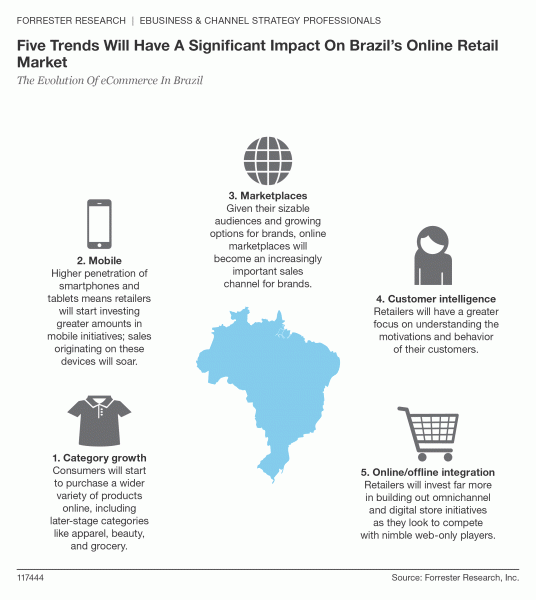eCommerce Evolution In Brazil
Many brands eyeing Latin American eCommerce markets look first to Brazil, and with good reason. Brazil is Latin America’s largest online retail market by a wide margin and growth rates remain high: Our forecast shows the market growing by a CAGR of 18% to reach $35 billion in 2018.
As in every fast-growing eCommerce market, however, companies that compete in this environment face numerous challenges. Issues like complex tax navigation and the long path to profitability are well documented. In addition, companies need to prepare for shifts in what consumers buy online and how they make these purchases. The dynamics of online shopping are shifting.
Our report published today on The Evolution Of eCommerce In Brazil (client access req’d) discusses five trends that will impact the online retail market in the country. While these same trends will play out in many markets around the globe, our report dives into how and when we expect to see shifts in Brazil.

For example, in Brazil:
The category mix will shift. Despite the fact that apparel is a popular online purchase category in Brazil, the online apparel market is still dwarfed by earlier-stage categories like consumer electronics and computer hardware. Consumer buying habits are changing, however – in the report, we quantify the degree to which later-stage categories like apparel and beauty will become a greater percentage of the total in the next few years.
Retailers will invest more time and resources in customer intelligence. Brazilian retailers typically collect a great deal of information on their customers, but only the savviest are analyzing and acting upon the data effectively to attract and retain customers. Few merge qualitative and quantitative insights to fully understand customer intent and behavior. As a benchmark, our report highlights how many analytics professionals are typical at global eBusinesses of different sizes given than Brazilian retailers are set to invest more heavily in this area.
Online/offline integration will gain momentum. Some Brazilian retailers were early movers when it came to connecting online and offline channels. For example, in places like São Paulo and Rio de Janeiro, tax incentives encourage consumers to provide their CPF (similar to a social security number) at the time of online or in-store purchase – forward-thinking retailers use these CPFs to track customer behavior. However, most retailers in Brazil face a long journey to full online/offline integration, and many face substantial technology and organizational hurdles: Some have explained upfront on their websites that in-store returns are impossible due to differing online and store systems. In the report, we highlight some of the initiatives underway and areas where we expect to investment over the next few years.
I’ll be talking about the five trends in this report at the eCommerce Brasil Forum in São Paulo next week – if you are a retailer or a solution provider in Brazil attending the event, I’d love to connect!